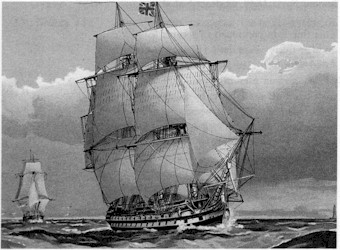The Death of a ’74’ – HMS Minotaur, 1810
An earlier blog article on this site described the loss of four large Royal Navy ships in a single storm off the Danish and Dutch coasts in December 1811. These vessels had been escorting a convoy from Gothenberg, Sweden, to London. The commander of one of the ships wrecked, HMS Hero, a “74”, launched in 1803, Captain James Newman-Newman (1767 – 1811) had expressed doubts about the prudence of sending convoys in this season. He had remarked “I cannot help thinking that we have been detained too long, and it is well if some of us do not share the fate of the Minotaur,” another “74” which had been lost almost exactly a year before. (Click here to read that earlier article). It is with the wreck of HMS Minotaur in 1810 that this present article deals.

The Battle of the Nile, 1798 – HMS Minotaur had come through with honour
Painting by Thomas Luny (1759 – 1837) – to read more about his life and work click here
HMS Minotaur, launched in 1793, had come through the battles of the Nile and of Trafalgar. In 1810, commanded by Captain John Barrett, she served in the Baltic. On 15th December HMS Minotaur sailed with two consorts from Gottenburg, heading for the Downs, a sheltered anchorage off the cost of Kent. By the evening of December 22nd she had lost contact with the two other ships. She was sailing with the advice of two experienced North Sea pilots and was believed to be north of the Netherlands. The uncertainty resulted from poor visibility that prevented solar or astral sightings, so that navigation would have been by dead reckoning, always an unreliable method in poor weather conditions. A strong wind was blowing from the south-east and HMS Minotaur, under close-reefed topsails and courses, was making just four knots.

As HMS Minotaur would have looked under full sail – in this case the ’74’ HMS Thunderer
At nine o’clock, Captain Barrett ordered that soundings should be taken every hour, under the immediate direction of the pilot. At midnight, the pilot of the watch suggested putting the vessel on the other tack. All hands were instantly turned up to do so, and at this moment when the ship struck bottom. The shock destroyed the steering and despite attempts were to back her off, HMS Minotaur was stuck fast. Fifteen feet water were reported in the hold and still rising. The officers and the whole of the ship’s company were assembled upon deck. The ship’s location was uncertain – the pilot of the watch thought she was on a shoal off the English coast but the other pilot believed that she had struck North Haacks (Noorderhaaks), a small island close to the larger Dutch island of Texel. The latter view proved to be correct.
Discipline prevailed, despite the ship rolling and pounding so violently that it was difficult for men to keep their feet. Captain Barrett had the masts were cut away (an undertaking that would have been difficult even in calm conditions) and as much possible was thrown overboard to lighten the ship. The darkness was so intense that it was impossible to see beyond a few yards but proximity to land was however indicated by the roar of the breakers. By daylight the forecastle was submerged and all boats other than the launch and two yawls had been destroyed, either by the falling of the masts, or by wave damage. At eight o’clock, HMS Minotaur parted amidships, and the sea made a clear breach over her. The gunner, a splendidly named Mr. Bones, volunteered to go off in a yawl to seek assistance from the shore. (It should be borne in mind that Britain was at war with the Netherlands, then essentially a French possession). Captain Barrett initially refused the offer, thinking it impossible that the boat could survive in such a sea. He agreed at last however and the gunner, with thirty-one of the crew, succeeded in launching the yawl and getting clear of the wreck.

Few artists have conveyed the terror of escaping from a wreck as Ivan Aivazovsky (1817 – 1900)
The desperation of those who took to HMS Minotaur’s boats would have been similar to that depicted here
HMS Minotaur was by now damaged beyond redemption. Broken timbers and spars washed around her and those still on board were crowded together on the poop and the quarter-deck. They watched the yawl’s slow progress towards shore – it took two hours – and it managed to land there safely. Heartened by this, the survivors managed to lift the launch into the water and many boarded. An hour later, it too managed to reach shore. The occupants were met and rounded up, as prisoners, by French soldiers stationed there. They implored Dutch officers, who were also present, to send boats to the aid of those still on the wreck but the requests were refused, though a boat were sent the next morning. Later in the morning, Captain Barrett and others attempted to reach the shore in the second yawl but it was swamped and all aboard were lost.

“The shipwreck of the Minotaur” by J.W.M. Turner (1775 – 1851) is probably inaccurate in detail but it conveys well the horror of attempting an escape in stormy conditions
By early afternoon the remains of HMS Minotaur’s shattered hull rolled over, taking with it the lives of some four-hundred man. A total of 110 of her crew had reached the shore – four of them by clinging to wreckage – and another twenty were rescued by a Dutch pilot vessel. The rescue craft sent next day found no survivors. There was considerable bitterness among the survivors against the Dutch authorities but considering the shallow water and the violence of the storm, this may have been unfair.
HMS Minotaur‘s survivors were marched off as prisoners to a prison camp in Valenciennes, in Northern France. Mr. Bones, the heroic gunner, escaped from there two months later. In an epic journey reminiscent of the later escapes of WW2 Allied prisoners of war, he travelled by night and concealed himself in barns and stables by day. He reached the Channel coast near Ostend some five weeks later and prevailed on the Belgian master of a fishing boat to land him in England against the promise of £50.

A ’74’ that survived extreme conditions – HMS Theseus in a hurricane, 1804
The other prisoners were repatriated at the end of hostilities in 1814. Only then could the court-martial for HMS Minotaur’s loss take place. Blame was placed on the pilots, both of whom had died, for having misjudged the ship’s location by over 60 miles because of the weather. Much bitterness was again expressed about the Dutch failure to take effective rescue measures. Even as late as 1850 a naval historian, William Stephen Gilly (1789-1855) stated that “There is not the slightest doubt but that, had the Dutch sent assistance, the greater part of the ship’s company would have been saved”. Two centuries on from the tragedy, one may question this. Greater guilt may indeed have been attributable to the Admiralty for not learning the lesson of sending ships into the area in storm conditions – and the result was to be yet heavier loss of life in the same waters twelve months later, as the ill-fated Captain Newman-Newman of HMS Hero was so hopelessly to fear.
Naval fiction enters the Age of Fighting Steam
If you’re a Kindle Unlimited subscriber you can read any of the seven Dawlish Chroniclesnovels without further charge. They are also available for purchase on Kindle or as stylish 9 X 6 paperbacks.
Click here or on cover images above for details
Here’s what readers have been saying about the Dawlish Chronicles in Amazon reviews:
 Registering for the Dawlish Chronicles mailing list, by clicking on any of the cover images below, will keep you updated on new books. You will also receive five free short stories for downloading on your Kindle, computer or tablet.
Registering for the Dawlish Chronicles mailing list, by clicking on any of the cover images below, will keep you updated on new books. You will also receive five free short stories for downloading on your Kindle, computer or tablet.


